CBS News Detroit debuts from loft-like space with touches of traditional set design
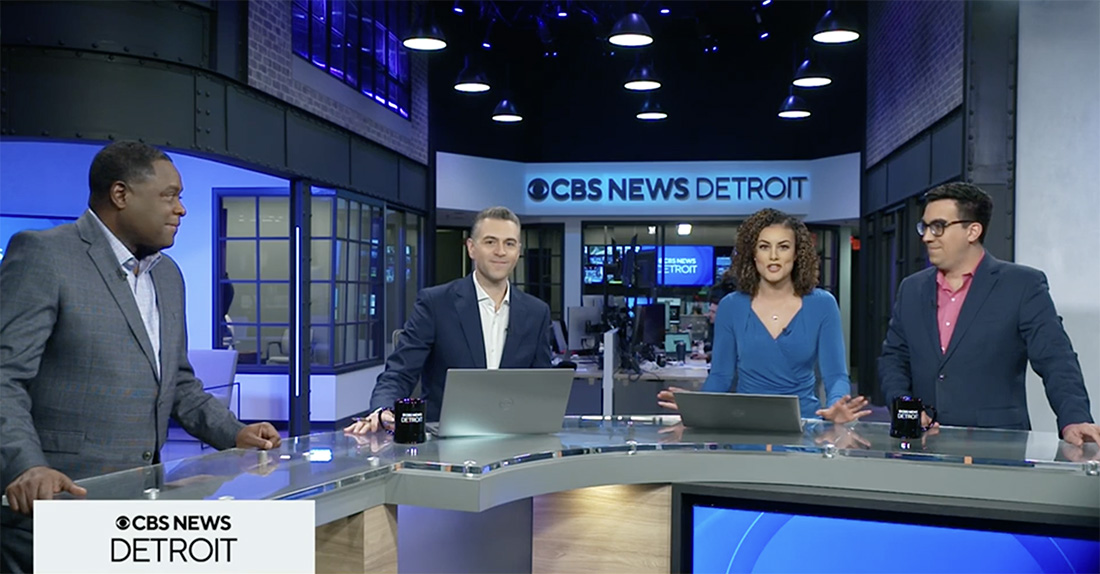
Subscribe to NCS for the latest news, project case studies and product announcements in broadcast technology, creative design and engineering delivered to your inbox.
With the return of local news to Detroit’s WWJ for the first time in over two decades, the station went with a non-traditional look for the home of its newscasts.
As an effort to channel the startup vibe of an upstart newsroom and as a nod to the city’s industrial heritage, CBS News Detroit broadcasts from an open space that combines a loft-like feel with more traditional broadcast design elements.
“I think there’s an essence of Detroit that we have captured in this, an innovative, gritty persona,” said Brian Watson, president and general manager, CBS News Detroit, in an interview with NewscastStudio. Watson noted this gritty, industrial style was something Detroit takes pride in and it was important the newsroom convey that pride.
For the broadcast, anchors sit at an L-shaped desk from FX Design Group that is placed within a working newsroom space that features a double-sided row of desks running down the middle. The overall design of the space was led by an architecture firm in charge of the building renovations.
“We want to make sure that the authenticity of the news product comes through,” said Watson. “There are so many opportunities to have more than just the anchors on camera. We’re going to turn that camera to the assignment desk. We’re going to turn it to a producer. We have lots of exciting plans in place for how to bring news in its most authentic way possible to the viewers of Detroit.”
Because the desk is placed in the middle of an open workspace, the other aspects of the studio were created by architectural firm Lindhout Associates who helped CBS renovate the station’s building to handle a full-fledged news operation.
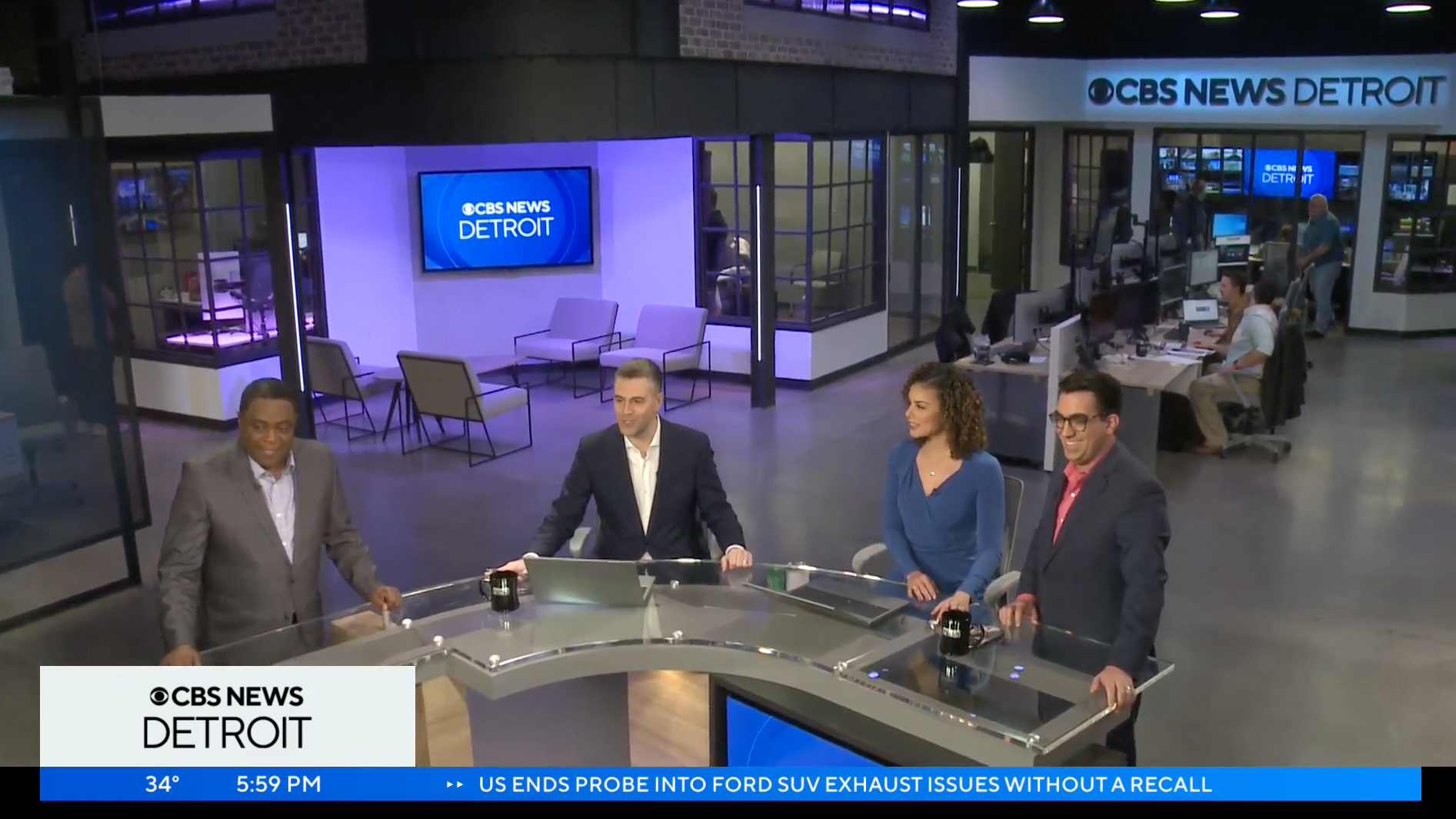

Behind this row of desks is a sliding glass door into an additional space outfitted with three large wall-mounted video panels. During broadcasts, the center one can be used to showcase a CBS News Detroit logo, while the other two are multiplexed to show various video sources. Above this wall is a large, dimensional installation of the CBS News Detroit logo in the network’s typeface of choice, TT Norms.
By flanking the center row of workstations with walls, the anchor desk two and wide shots background creates the feel of looking down a narrow galley-like space with the sliding glass door and banner above serving as the focal point.
This banner is spotlighted using a tinted splash of light, making it pop thanks to the color shift and shadows created by the lighting design from Lonnie Juli and Angry Badger Productions. The newsroom space includes Litepanels Gemini 1X1 Hard panels, Astra 6X Bi-Color LED panels and Chauvet Ovation fixtures using an ETCnomad for control.
On either side of the workstations are additional windowed spaces that largely use the look of traditional industrial-style windows with dark, prominent grilles.
Above these is a header with the feel of worn metal panels installed with large bolts, a motif that’s also carried through to on-camera columns.
While some of the steel accents are real, Lindhout sourced much of the faux cladding from Feather Beams and Trusses.
Even farther up from the floor is a mezzanine level fronted with a gray brick-like pattern with an additional backlit window on one side.
The work area is lit with nine distinct industrial kettle-shaped light fixtures arranged in a 3×3 pattern. Additional, smaller spotlights cast splashes of light on the walls and other parts of the space.
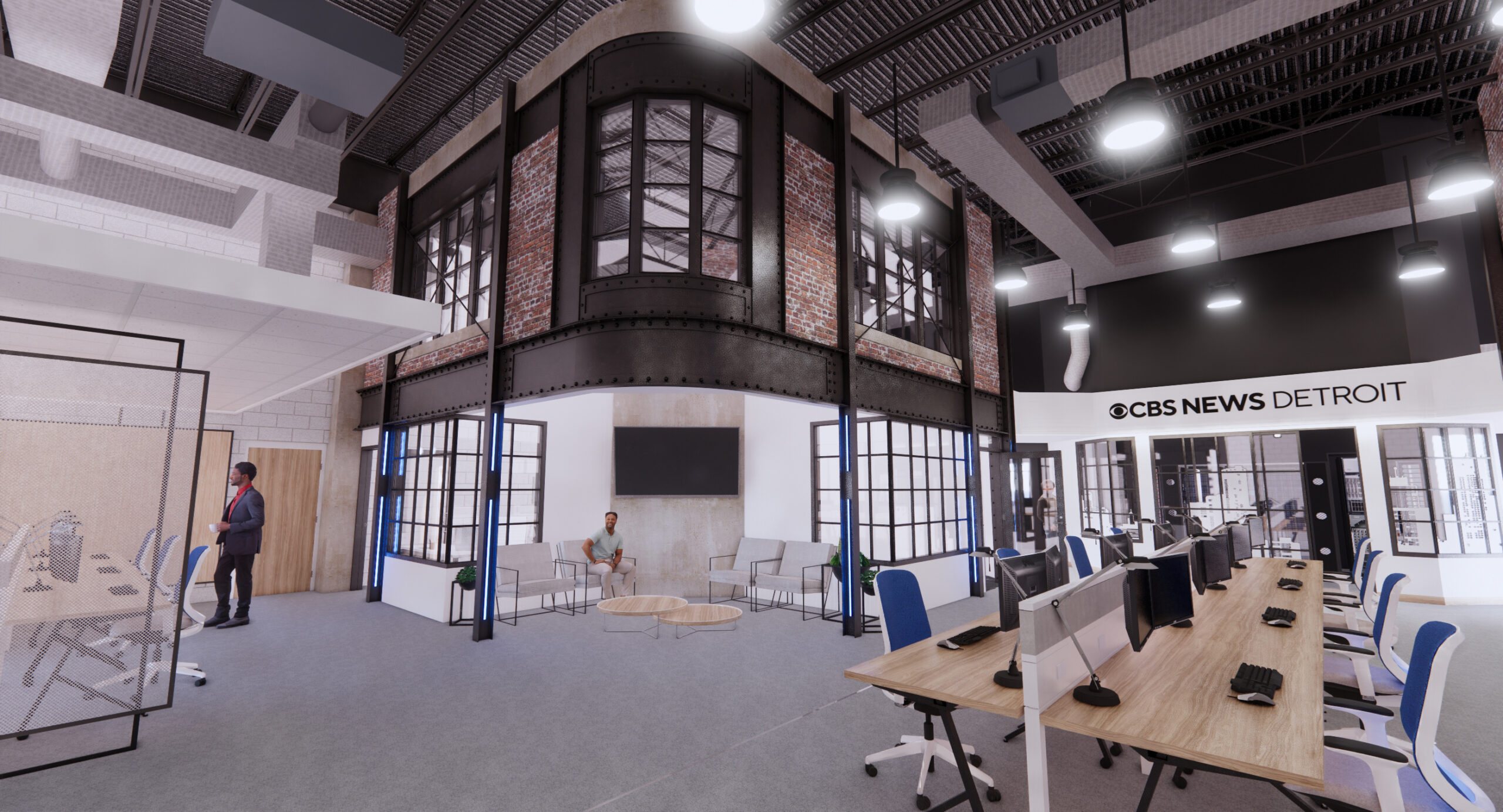

As the two walls that run parallel to the row of workstations come close to the anchor area, they spread out, another design decision that drives home the dramatic narrow look of the area.
Camera left features a four-seat lounge area with a large video panel installed on a diagonal wall. This space is largely washed with colored lighting and its position in relation to the anchor desk allows the panel to serve an OTS-style monitor for the far camera left position, typically used by sports.
This area is capped with a curved extension of the industrial-style header that makes this part of the space feel like a secondary focal point. Camera left of this is the start of an alley-like walkway lined with additional windows and workspaces.
The station opted to keep the clean armchairs and coffee table in this space devoid of any staffers. However, it seems primed to double as a collaborative workspace or for shooting interviews or informal segments.
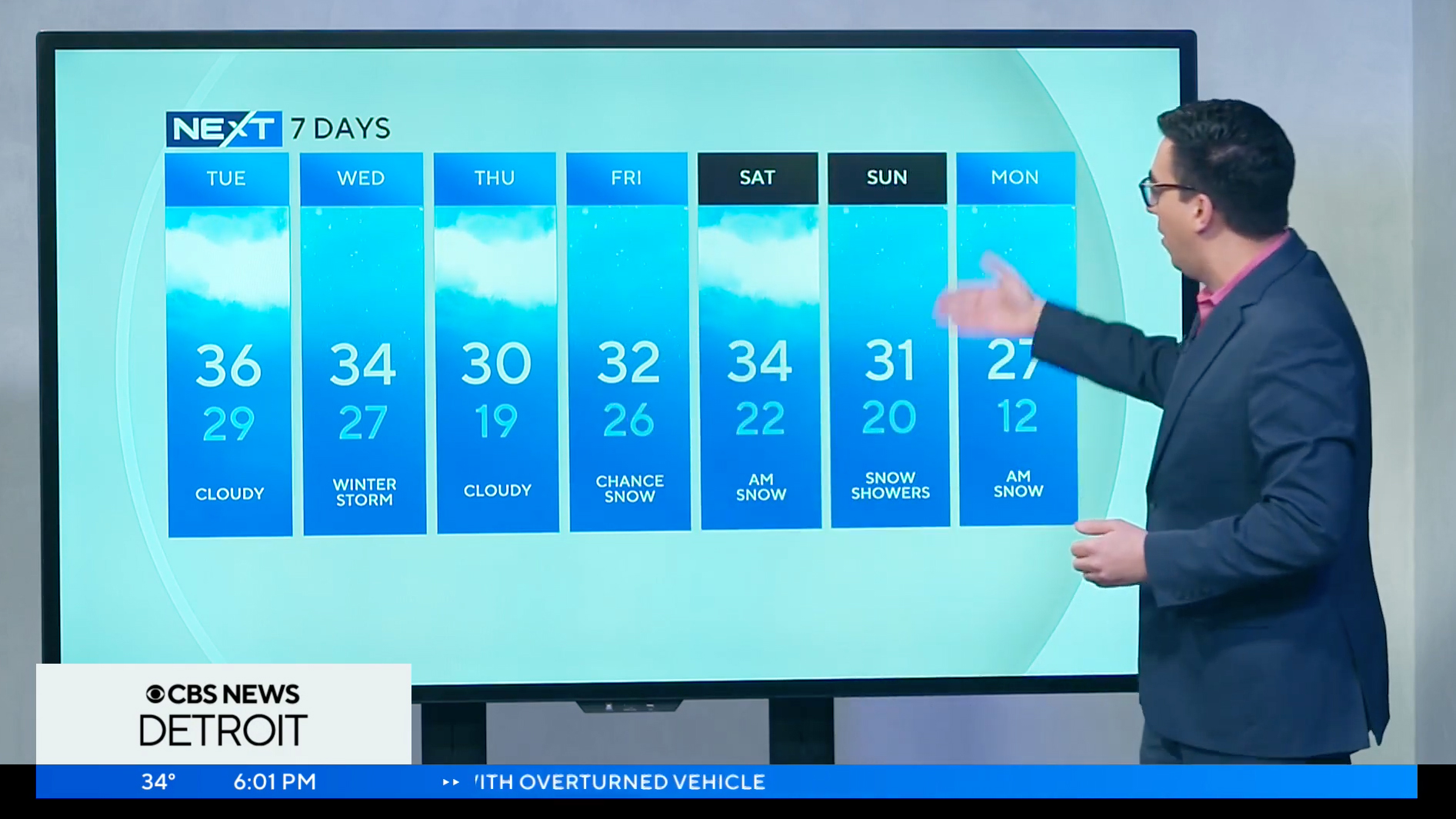

WWJ’s weather, branded under the ‘Next Weather‘ name used by other CBS-owned stations, is presented on a freestanding video panel instead of using a chroma key. The station also uses weather graphics that are noticeably different from what other CBS-owned stations have been using, integrated with the station’s The Weather Company weather system.
On the other side of the work area is a subtly-textured light wall that serves as one part of the weather center. A large, freestanding mobile video panel here serves as the primary weather presentation space, eschewing the use of a chroma key wall.
The panel is placed in a 90-degree corner that, when it changes decoration, is emblazoned with half of an oversized CBS eye logo in a dark gray.
This juts right up against a lighter wood toned-wall that backs up to a row of weather workstations, which feature wall-mounted panels above.
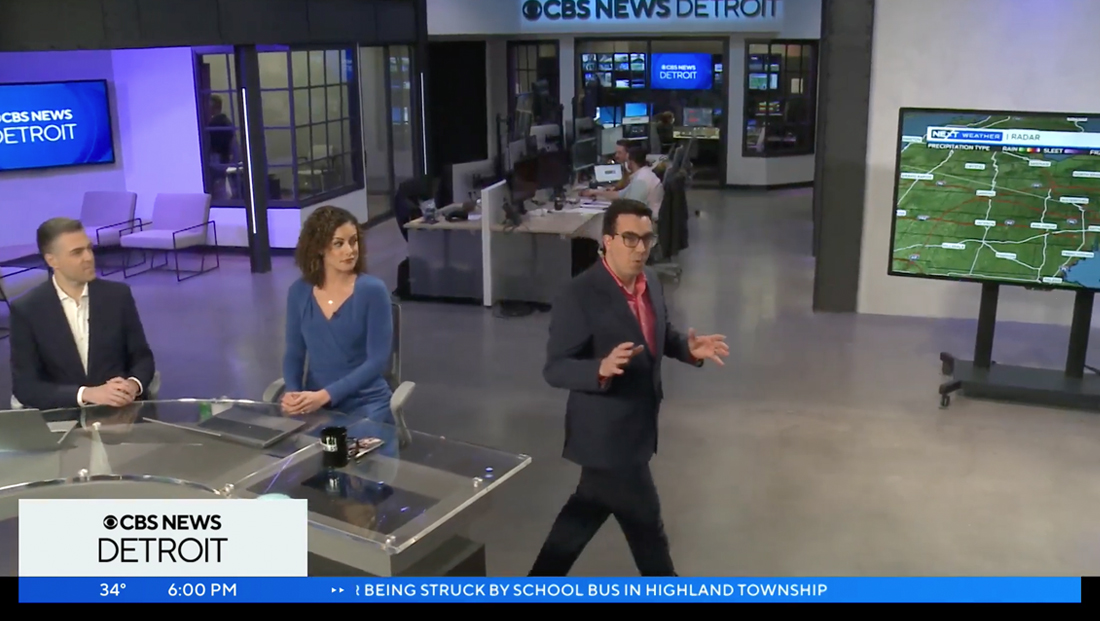

A small, manual jib in the space is used for both bump shots and to transition between news and weather when the on-camera forecaster departs the far camera right standing position at the desk and walks over to the large video panel to deliver a report.
Back at home base, the anchor desk is one of the more prominent parts that channels a traditional news set. It’s created using a blend of glass, gray and light wood along with an integrated video panel.
The camera right three-fourths of the desk is the same depth as it curves around the corner created by its L-shape, while the far camera left surface is roughly two-thirds of the depth and also includes an open front that serves to visually separate it from the rest of the desk.
During its debut, WWJ shot the anchor desk slightly off-axis due to the placement in the newsroom and the desk’s shape.
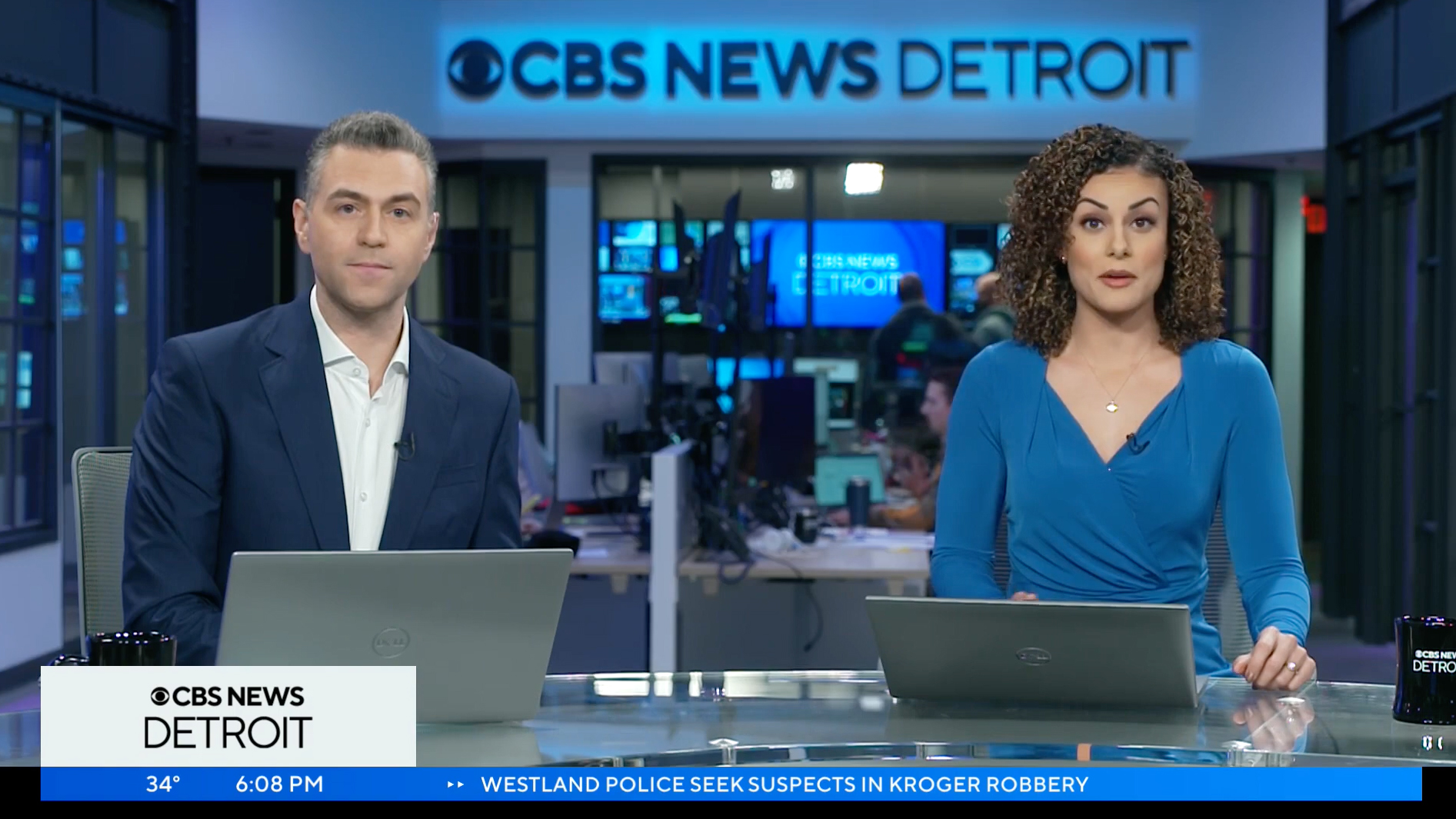

This results in a slightly off-center two-shot, with the logo banner not quite centered in frame and the workstations’ row of arm-mounted monitors ending up almost directly between the two anchors.
It appears that this shot was framed, at least in part, so that the CBS News Detroit video panel is almost entirely visible between the anchors, although the sliding glass door’s mullion often cuts off the far left side of the design.
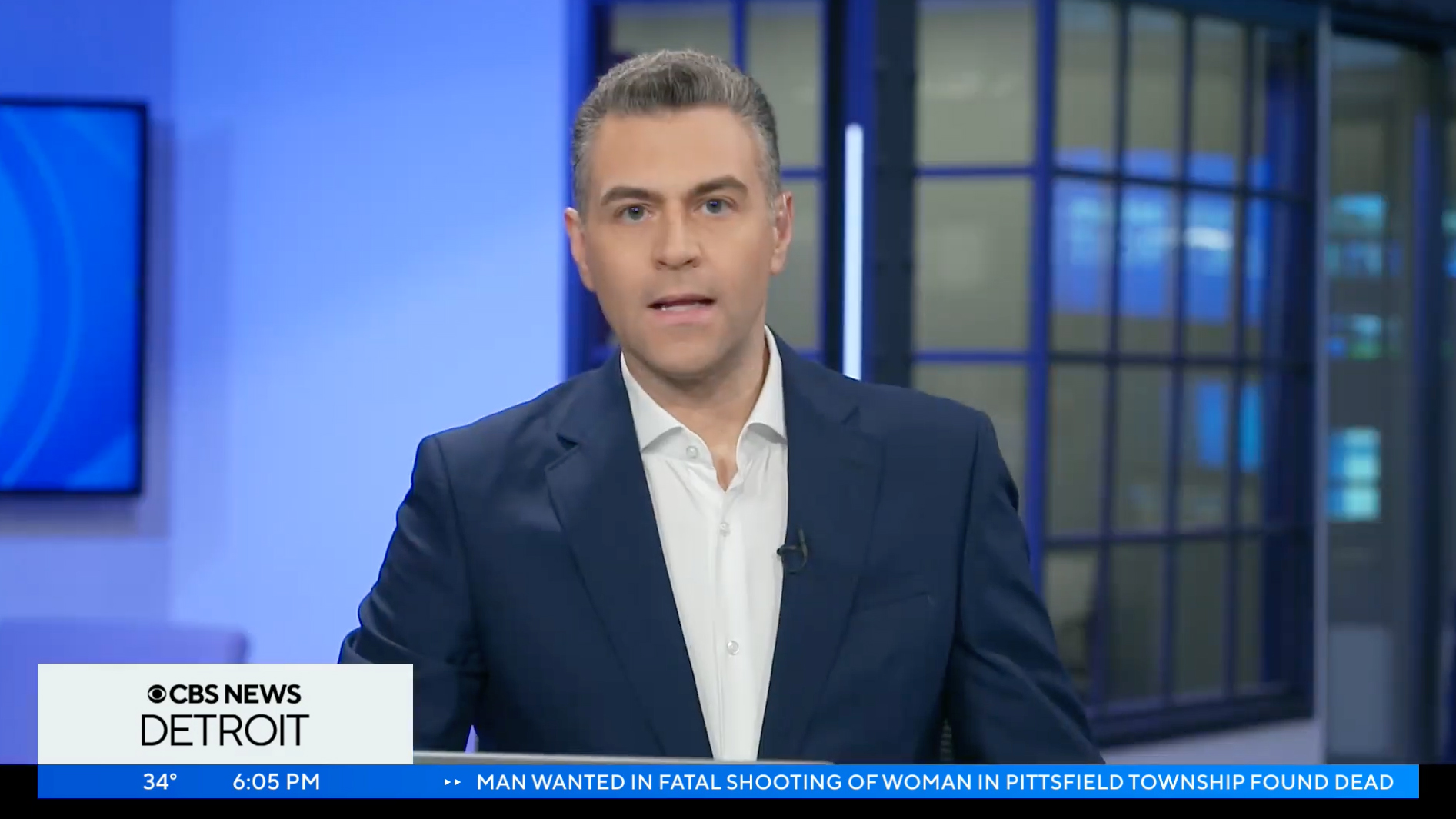

The camera left anchor one shot features a portion of the lounge area’s monitor, a portion of a windowed, enclosed workspace along with one of the columns, which has been thoughtfully accented with a thin line of LED.
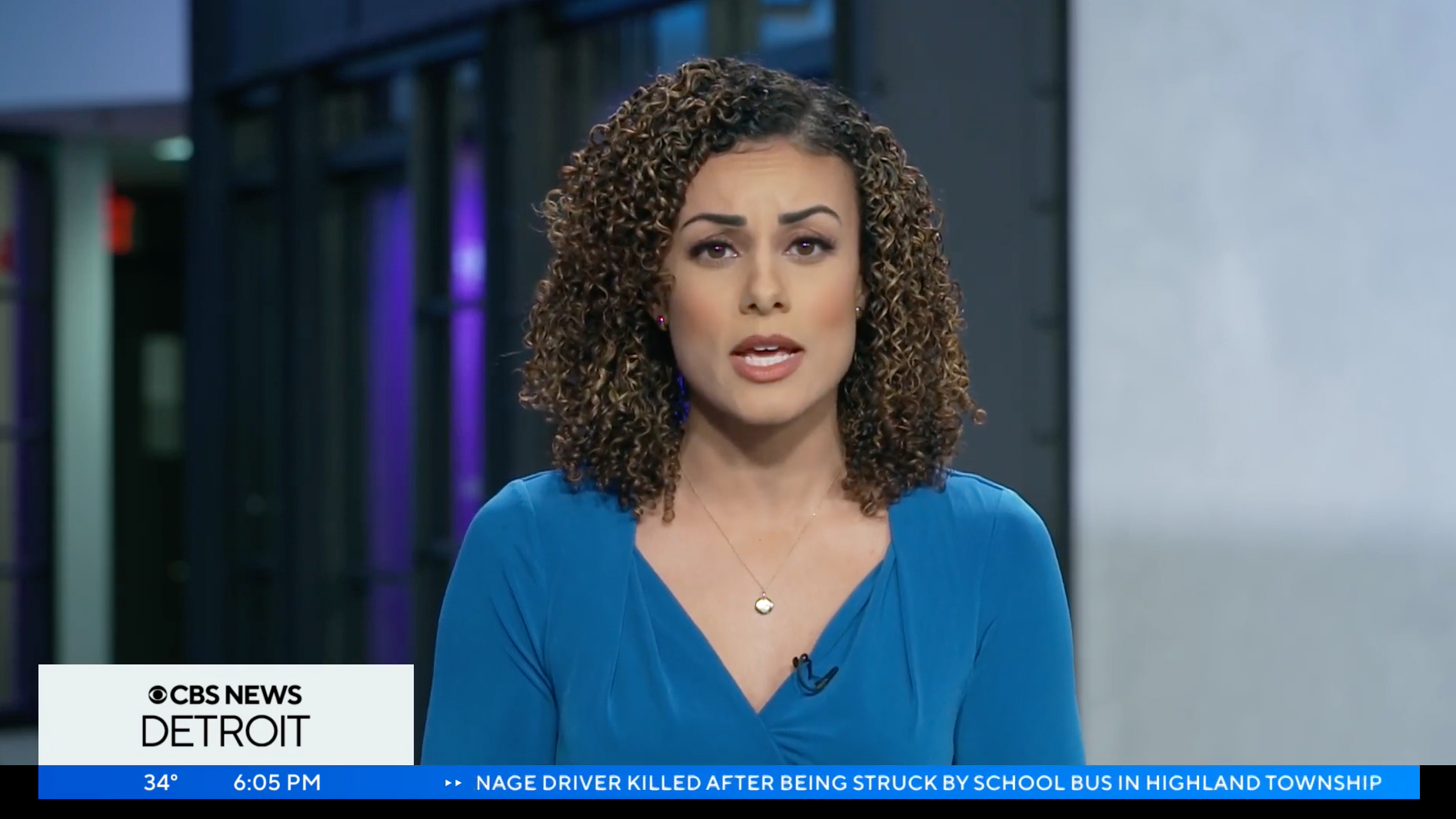

Camera right features a rather indistinct view of a row of windows, a part of the light gray weather area wall and a small alcove in the far corner of the space. There’s also a portion of a red exit sign what appears to be a red fire alarm visible in this view.
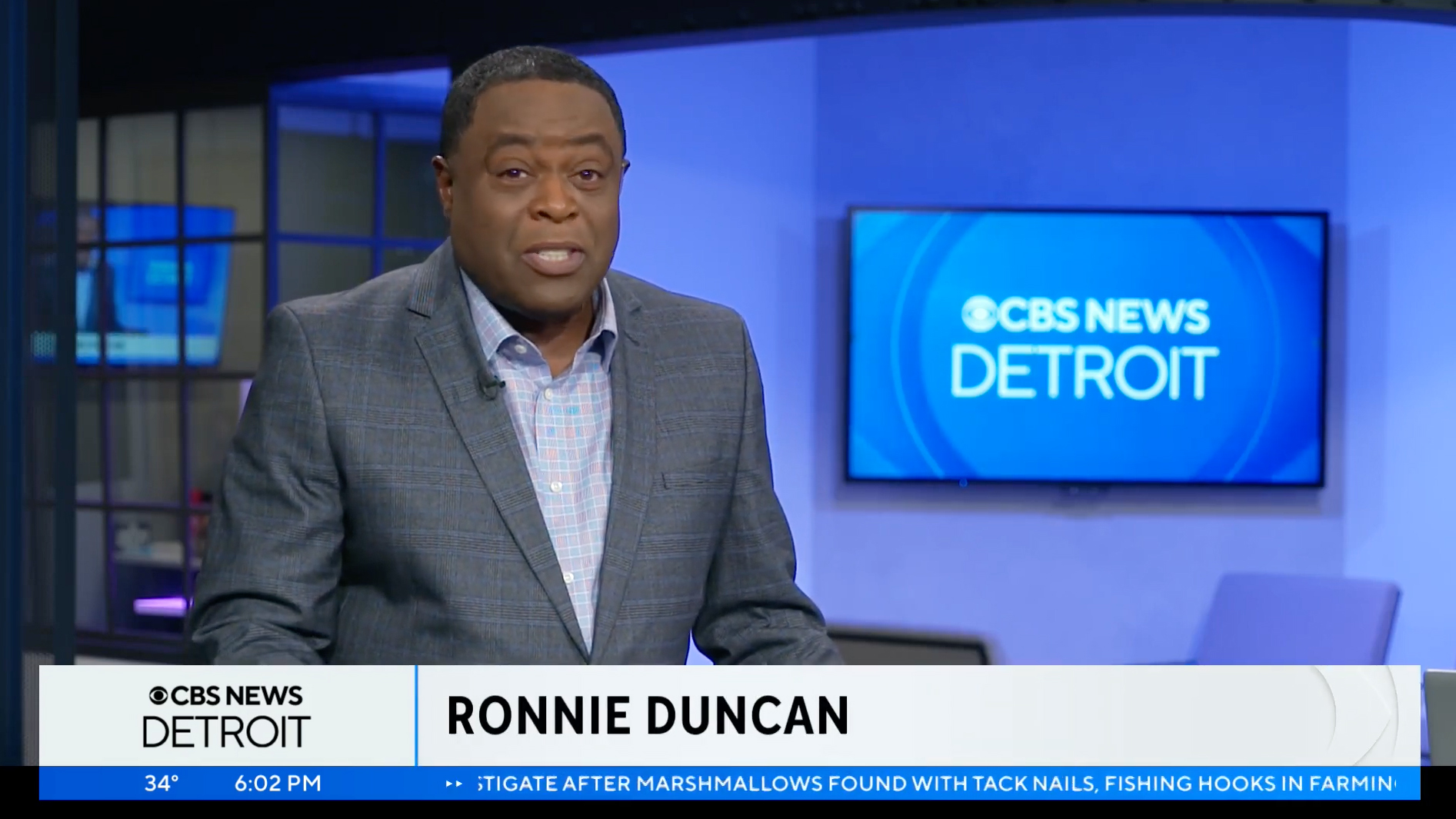

That far camera left shot, meanwhile, is arguably the best blocked shot, though it appeared slightly off-kilter at times and also captures a wall-mounted TV showing the station’s live feed that, thanks to signal delays, is slightly out of sync with what the viewer is seeing. It’s also unlikely that the seating area could ever be used while on air and using this background.
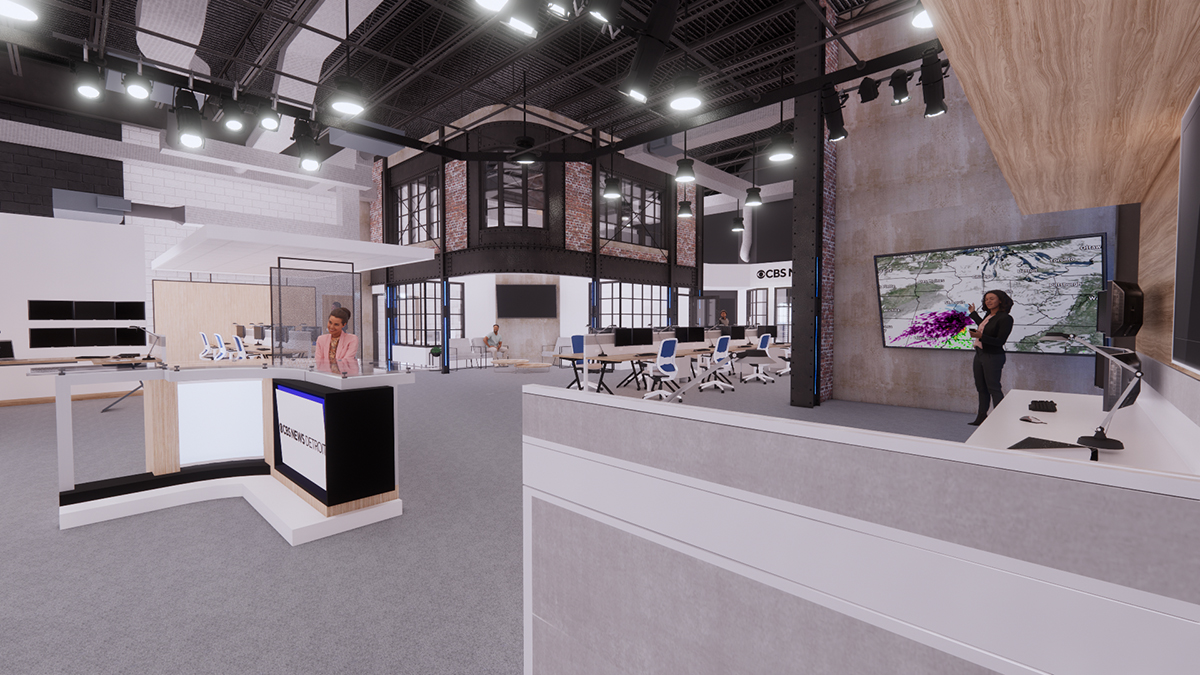

A bit farther camera left is a see-through metallic divider screen and another row of workstations.
Other vendors include CueScript for prompting, Sony for cameras and Clear-Com for IFB and comms.
During the updates, consulting mechanical engineers MEEC were charged with reversing the air supply orientation from the old 1980s set layout and also working with oversized duct supplies that were based on old analog systems and big theater lights.
One element that the CBS Detroit set notably excludes is a large video wall — a very common element on news sets, including other CBS-owned stations.
That said, CBS has been on the record as saying its strategy CBS News Detroit is to make it more focused on “community journalism,” so it’s perhaps logical that the station opted not to invest more heavily in its in-studio storytelling tools.
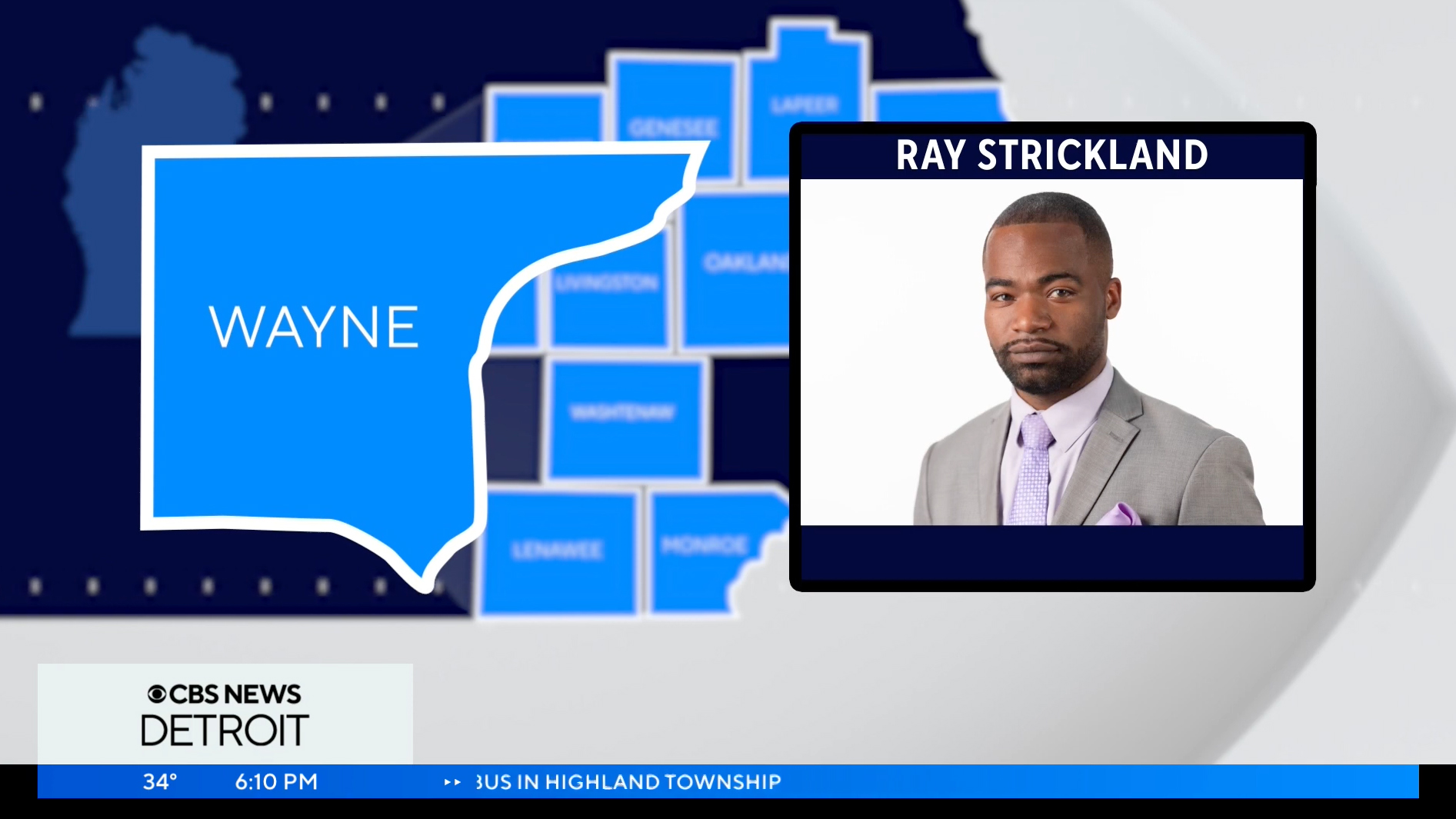

CBS News Detroit uses the new graphics package first debuted at KPIX in San Fransisco and KCBS-KCAL in Los Angeles, though the focus on the community is evident in a unique element — a map based graphic that allows the station to call out, county-by-county, the locale of a story along with a reporter mug.
Renders courtesy Lindhout Associates.
Subscribe to NCS for the latest news, project case studies and product announcements in broadcast technology, creative design and engineering delivered to your inbox.






tags
Angry Badger Productions, CBS News Detroit, CBS O&O, CBS Stations, Chauvet, Clear-Com, CueScript, detroit, ETC, FX Design Group, Litepanels, Litepanels Astra, Litepanels Gemini, Lonnie Juli, Sony, WWJ
categories
Broadcast Industry News, Heroes, Local News, News Set Design, Set Design